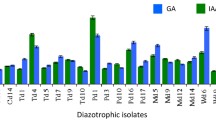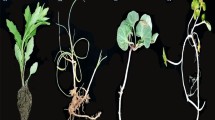Abstract
This study assessed potential of plant growth promoting rhizobacteria (PGPR) found in 34 soil samples collected from Sirmaur, Himachal Pradesh. Out of 238 rhizobacterial isolates, 48 rhizobacterial isolates exhibited multiple PGP (plant growth promoting) traits. Out of the 48 isolates, nine isolates exhibiting most promising PGP traits were evaluated. CSRS12 isolate showed maximum solubilization of phosphate and potassium up to 530.71 and 30.44 mg l−1, respectively. Maximum zinc solubilizing efficiency (ZSE) was also observed in case of isolate CSRS12. The maximum IAA production was observed by isolate PPRS17 with 37.34 mg l−1 followed by PCRS24 with 34.44 mg l−1 after 120 h. Maximum siderophore unit production was observed upto 92.29% by isolate CSRS12 followed by 65.54% with isolate TA1PS. The selected PGPR isolates were identified through 16S rDNA sequencing. The identified PGPRs were Burkholderia arboris (isolate CSRS12), Pseudomonas aeruginosa (isolate PPRS17) and Acinetobacter baumannii (isolate TA1PS). B. arboris CSRS12 isolate showed multiple PGP traits as mineral solubilization of phosphate, potassium and zinc, production of siderophore and ammonia. Among all three PGPR treatment, B. arboris CSRS12 isolate showed significant increment in lateral root number, root and shoot length, fresh and dry weight of root and shoot of mung bean (Vigna radiata) in pot experiments. The results showed that CSRS12 isolate could be used for exploitation as bio-inoculant, which can facilitate better productivity and ecological dynamics for both domesticated crops as well as wild varieties.


Similar content being viewed by others
References
Singh TB, Ali A, Prasad M, Yadav A, Shrivastav P, Goyal D, Dantu PK (2020) Role of organic fertilizers in improving soil fertility. In: Naeem M, Ansari AA, Gill SS (eds) Contaminants in agriculture. Springer, Cham, pp 61–77
Cakmakci R, Dönmez MF, Erdoğan Ü (2007) The effect of plant growth promoting rhizobacteria on barley seedling growth, nutrient uptake, some soil properties, and bacterial counts. Turk J Agric For 31:189–199
Glick BR (1995) The enhancement of plant growth by free living bacteria. Can J Microbiol 41:109–114
De Meyer SE, De Beuf K, Vekeman B (2015) A large diversity of nonrhizobial endophytes found in legume root nodules in Flanders (Belgium). Soil Biol Biochem 83:1–11
Farina R, Beneduzi A, Ambrosini A, de Campos SB, Lisboa BB, Wendisch V et al (2012) Diversity of plant growth-promoting rhizobacteria communities associated with the stages of canola growth. Appl Soil Ecol 55:44–52
Saharan BS, Nehra V (2011) Plant growth promoting rhizobacteria: a critical review. Life Sci Med Res 21:1–30
Adesemoye AO, Kloepper JW (2009) Plant-microbes interactions in enhanced fertilizer use efficiency. Appl Microbiol Biotechnol 85:1–12
Pandey A, Trivedi P, Kumar B, Palni LMS (2006) Characterization of a phosphate solubilizing and antagonistic strain of Pseudomonas putida (B0) isolated from a sub-alpine location in the Indian Central Himalaya. Curr Microbiol 53(2):102–107
Duffy BK, Ownley BH, Weller DM (1997) Soil chemical and physical properties associated with suppression of take-all of wheat by Trichoderma koningii. Phytopathology 87:1118–1124
Ashrafuzzaman M, Hossen FA, Ismail MR, Hoque A, Islam MZ, Shahidullah SM et al (2009) Efficiency of plant growth-promoting rhizobacteria (PGPR) for the enhancement of rice growth. Afr J Biotechnol 8(7):1247–1252
Satyanarayana T, Raghukumar C, Shivaji S (2005) Extremophilic microbes: diversity and perspectives. Curr Sci 89:78–90
Zarrin F, Saleemi M, Zia M, Sultan T, Aslam M, Rehman R et al (2009) Antifungal activity of plant growth-promoting rhizobacteria isolates against Rhizoctonia solani in wheat. Afr J Biotechnol 8(2):219–225
Tang YW, Bonner J (1948) The enzymatic inactivation of indole acetic acid. II. The physiology of the enzyme. Am J Bot 35:570–578
Gordon SA, Weber RP (1951) Colorimetric estimation of inodole acetic acid. Plant Physiol 26:192–195
Gaur AC (1990) Physiological functions of phosphate solubilizing microorganisms. In: Gaur AC (ed) Phosphate solubilizing microorganisms as biofertilizers. Omega Scientific Publishers, New Delhi, pp 16–72
Vazquez P, Holguin G, Puente ME, Lopez-Cortes A, Bashan Y (2000) Phosphate solubilizing microorganisms associated with the rhizosphere of mangroves growing in a semiarid coastal lagoon. Biol Fert Soils 30:460–468
Barton CJ (1947) Photometric analysis of phosphate rock. Anal Chem 20:1068–1073
Hu X, Chen J, Guo J (2006) Two phosphate and potassium solubilizing bacteria isolated from Tianmu Mountain, Zhejiang, China. World J Microb Biot 22:983–990
Schwyn B, Neilands JB (1987) Universal chemical assay for the detection and determination of siderophores. Anal Biochem 160(1):47–56
Alexander DB, Zuberer DA (1991) Use of chrome azurol S reagents to evaluate siderophore production by rhizosphere bacteria. Biol Fertil Soils 12:39–45
Cappuccino JG, Sherman N (1992) Biochemical activities of microorganisms. Microbiology, a laboratory manual. The Benjamin/Cummings Publishing Co. California, USA, 188-47.
Holt JG, Krieg NR, Sneath P, Staley J, Williams S (1994) Bergey's manual of determinative bacteriology, 9th edn. Williams and Wilkins, Baltimore, p 7879
Araujo WL, Marcon J, Maccheroni Jr W, Elsas JD, Vuurde JWL, Azevedo JL, (2002) Diversity of endophytic bacterial populations and their interaction with Xylella fastidiosa in citrus plants. Appl Environ Microbiol 68(10):4906–4914
Kumar S, Stecher G, Li M, Knyaz C, Tamura K (2018) MEGA X: molecular evolutionary genetics analysis across computing platforms. Mol Biol Evol 35:1547–1549
Nezarat S, Gholami A (2009) Screening plant growth promoting rhizobacteria for improving seed germination, seedling growth and yield of maize. Pak J Biol Sci 12(1):26–32
Bardou P, Mariette J, Escudié F, Djemiel C, Klopp C (2014) J Venn: an interactive Venn diagram viewer. BMC Bioinform 15(1):293
Liu X, Jiang X, He X, Zhao W, Cao Y, Guo T et al (2019) Phosphate-solubilizing Pseudomonas sp. strain P34-L promotes wheat growth by colonizing the wheat rhizosphere and improving the wheat root system and soil phosphorus nutritional status. J Plant Growth Regul 38:1314–1324
Munir I, Bano A, Faisal M (2019) Impact of phosphate solubilizing bacteria on wheat (Triticum aestivum) in the presence of pesticides. Braz J Biol 79(1):29–37
Behera BC, Yadav H, Singh SK, Mishra RR, Sethi BK, Dutta SK et al (2017) Phosphate solubilization and acid phosphatase activity of Serratia sp isolated from mangrove soil of Mahanadi river delta, Odisha. J Genet Eng Biotechnol 15(1):169–178
Zhao K, Penttinen P, Zhang X, Ao X, Liu M, Yu X et al (2014) Maize rhizosphere in Sichuan, China, hosts plant growth promoting Burkholderia cepacia with phosphate solubilizing and antifungal abilities. Microbiol Res 169(1):76–82
Kumar V, Singh P, Jorquera MA, Sangwan P, Kumar P, Verma AK et al (2013) Isolation of phytase-producing bacteria from Himalayan soils and their effect on growth and phosphorus uptake of Indian mustard (Brassica juncea). World J Microb Biot 29(8):1361–1369
Singh TB, Sahai V, Ali A, Prasad M, Yadav A, Shrivastav P, Goyal D, Dantu PK (2020) Screening and evaluation of PGPR strains having multiple PGP traits from hilly terrain. J Appl Biol Biotechnol 8:38–44
Goldstein AH (1994) Involvement of the quino protein glucose dehydrogenase in the solubilization of exogeneous mineral phosphates by gram negative bacteria. phosphate in micro-organisms: cellular and molecular biology. ASM Press, Washington, DC, pp 197–203
Parmar P, Sindhu SS (2019) The novel and efficient method for isolating potassium solubilizing bacteria from rhizosphere soil. Geomicrobiology J 36(2):130–136
Pramanik P, Goswami AJ, Ghosh S, Kalita C (2019) An indigenous strain of potassium-solubilizing bacteria Bacillus pseudomycoides enhanced potassium uptake in tea plants by increasing potassium availability in the mica waste-treated soil of North-east India. J Appl Microbiol 126(1):215–222
Khanghahi MY, Pirdashti H, Rahimian H, Nematzadeh G, Sepanlou MG (2018) Potassium solubilising bacteria (KSB) isolated from rice paddy soil: from isolation, identification to K use efficiency. Symbiosis 76(1):13–23
Maurya BR, Meena VS, Meena OP (2014) Influence of Inceptisol and Alfisol’s potassium solubilizing bacteria (KSB) isolates on release of K from waste mica. Vegetos 27(1):181–187
Buragohain S, Nath DJ, Devi YB, Bhattacharyya B, Dutta S (2018) Molecular characterization of potassium solubilizing bacteria from crop rhizosphere of the North Eastern Region of India. Curr Sci 114(12):2543–2548
Shrivastav P, Prasad M, Singh TB, Yadav A, Goyal D, Ali A, Dantu PK (2020) Role of nutrients in plant growth and development. In: Naeem M, Ansari AA, Gill SS (eds) Contaminants in agriculture. Springer, Cham, pp 43–59
Mumtaz MZ, Ahmad M, Jamil M, Hussain T (2017) Zinc solubilizing Bacillus spp. potential candidates for biofortification in maize. Microbiol Res 202:51–60
Kamran S, Shahid I, Baig DN, Rizwan M, Malik KA, Mehnaz S (2017) Contribution of zinc solubilizing bacteria in growth promotion and zinc content of wheat. Front Microbiol 8:02593
Patten CL, Glick BR (2002) Role of Pseudomonas putida indole acetic acid in development of the host plant root system. Appl Environ Microbiol 68:3795–3801
Zahir ZA, Shah MK, Naveed M, Akhter MJ (2010) Substrate-dependent auxin production by Rhizobium phaseoli improves the growth and yield of Vigna radiata L. under salt stress conditions. J Microbiol Biotechnol 20:1288–1294
Chandra S, Askari K, Kumari M (2018) Optimization of indole acetic acid production by isolated bacteria from Stevia rebaudiana rhizosphere and its effects on plant growth. J Genet Eng Biotechnol 16(2):581–586
Goswami D, Pithwa S, Dhandhukia P, Thakker JN (2014) Delineating Kocuria turfanensis 2M4 as a credible PGPR: a novel IAA- producing bacteria isolated from saline desert. J Plant Interact 9(1):566–576
Ahmad F, Ahmad I, Khan MS (2008) Screening of free-living rhizospheric bacteria for their multiple plant growth promoting activities. Microbiol Res 163:173–181
Chaiharn M, Chunhaleuchanon S, Lumyong S (2009) Screening siderophore producing bacteria as potential biological control agent for fungal rice pathogens in Thailand. World J Microbiol Biotechnol 25(11):1919–1928
Tagele SB, Kim SW, Lee HG, Lee YS (2019) Potential of novel sequence type of Burkholderia cenocepacia for biological control of root rot of maize (Zea mays L.) caused by Fusarium temperatum. Int J Mol Sci 20(5):1005
Jha A, Sharma D, Saxena J (2012) Effect of single and dual phosphate-solubilizing bacterial strain inoculations on overall growth of mung bean plants. Arch Agron Soil Sci 58(9):967–981
Ahmad M, Adil Z, Hussain A, Mumtaz MZ, Nafees M, Ahmad I et al (2019) Potential of phosphate solubilizing Bacillus strains for improving growth and nutrient uptake in mungbean and maize crops. Pak J Agric Sci 56(2):283–289
Acknowledgements
Authors are thankful to Council of Scientific & Industrial Research, New Delhi and Department of Science and Technology, Inspire, Government of India for providing Junior Research Fellowship and Senior Research Fellowship. The authors also acknowledge the Director, Dayalbagh Educational Institute, for the financial support to carry out this work.
Author information
Authors and Affiliations
Corresponding author
Ethics declarations
Conflict of interest
The authors declare no conflict of interest.
Additional information
Publisher's Note
Springer Nature remains neutral with regard to jurisdictional claims in published maps and institutional affiliations.
Electronic supplementary material
Below is the link to the electronic supplementary material.
Rights and permissions
About this article
Cite this article
Singh, T.B., Sahai, V., Goyal, D. et al. Identification, Characterization and Evaluation of Multifaceted Traits of Plant Growth Promoting Rhizobacteria from Soil for Sustainable Approach to Agriculture. Curr Microbiol 77, 3633–3642 (2020). https://doi.org/10.1007/s00284-020-02165-2
Received:
Accepted:
Published:
Issue Date:
DOI: https://doi.org/10.1007/s00284-020-02165-2




